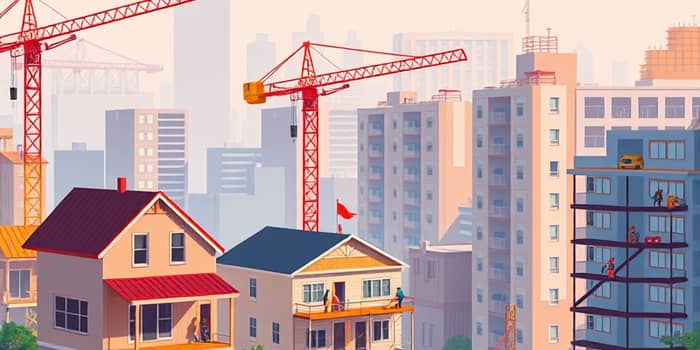
In recent months the U.S. housing market has experienced a notable slowdown in new construction activity. May 2025 data shows that housing starts declined by 9.8 percent from April to an annualized rate of 1.26 million units. This sharp pullback has surprised many analysts and disrupted momentum from a modest rebound in April when starts rose by 1.6 percent. The current trend highlights the profound influence that financing costs and economic sentiment exert over homebuilding decisions.
April 2025 saw housing starts reach 1.361 million units, buoyed by a 10.7 percent increase in multi-family construction even as single-family starts dipped by 2.1 percent. Yet the latest figures leave overall starts well below the long-term historical average of 1.432 million units. Builders are clearly grappling with surging mortgage rates penalize buyers and a more cautious lending environment that has eroded momentum across the sector.
Regional activity underscores this uneven recovery. The Northeast posted a 12.9 percent gain in April while the South climbed by 11.0 percent. In contrast the West saw a 16.1 percent drop and the Midwest fell by 10.8 percent. These regional disparities in housing starts reflect disparate local market dynamics ranging from regulatory hurdles to varying levels of investor interest.
Mortgage rates surged from around 3.5 percent in 2021 to roughly 7 percent by the end of 2022. Fannie Mae forecasts that rates will remain above 6.5 percent through at least 2027. This affordability crisis for first-time buyers has sidelined many would-be homeowners who cannot qualify for higher monthly payments or sizable down payments amid stricter lending standards.
The spike in borrowing costs has also driven refinance activity to its lowest levels in years and pushed existing home sales to 14-year lows. As buyers pause to reassess their budgets builders face mounting uncertainty about demand. Local lenders are increasingly cautious in extending credit for new projects further suppressing the pace of groundbreaking and planning approvals.
Despite the slowdown in starts, the inventory of newly built homes has climbed sharply. New homes for sale reached 481,000 units—the highest level since 2007—and speculative spec homes are at 385,000 units, the most since 2008. These levels sit roughly 50 percent above long-term averages according to leading financial analysts.
Yet total housing inventory remains below pre-crisis norms leaving an underlying structural shortage of housing persists. This gap between supply and demand is further complicated by constrained labor markets and rising material costs that delay project completion. Home price appreciation has eased but remains positive, with an average U.S. home value of $367,969 as of July 2025, up 0.8 percent year over year.
Homebuilder confidence as measured by the National Association of Home Builders Index has remained below the neutral 50 level since August 2023. Despite two consecutive monthly gains confidence readings are still in negative territory, indicating that many developers remain hesitant to ramp up activity. homebuilder confidence remains below average across most regions, reflecting concerns about demand and input costs.
Broader economic headwinds also play a role. Slower GDP growth projections coupled with demographic shifts including lower birth rates and reduced immigration dampen long-term housing forecasts. Meanwhile permits fell 4.7 percent in April to 1.41 million units and the count of homes under construction dropped 15 percent over the last year, underscoring the cautious stance of builders amid recession risks.
To revitalize construction activity stakeholders must collaborate on both policy reforms and market innovations. At the local level municipalities can streamline approval processes and reduce fees that inflate project timelines. State and federal policymakers can consider targeted incentives such as tax credits or direct subsidies for projects that include affordable units.
Meanwhile the private sector can invest in modular and prefab construction techniques to lower costs and accelerate build times. Public-private partnerships can further share risks and align goals toward increasing supply in high-need communities. By focusing on incentives for affordable housing development officials and builders can begin to claw back lost momentum.
Even in a challenging financing environment buyers can take proactive steps to improve their prospects. Locking in a rate with a mortgage lock program can shield applicants from further rate volatility. Exploring first-time buyer assistance programs and negotiating incentives such as seller concessions or closing cost help can also reduce upfront burdens.
Families may also consider emerging markets where land and labor costs remain more affordable. By approaching the search process strategically and staying informed about local incentives buyers can navigate the slowdown with greater confidence and resilience. A focus on strategic timing for mortgage applications can yield substantial savings over the life of a loan.
Forecasts from leading industry forecasters predict total housing starts of 1.35 million in 2025 and 1.37 million in 2026—both below the long-term average dating back to 1959. While these projections reflect tempered expectations they also highlight the need for concerted efforts to close a cumulative shortfall of nearly 3.7 million homes.
The contrast between elevated inventories of new and spec homes and an enduring structural deficit underscores the complexity of the current challenge. Overcoming this requires innovation in design, financing, and policy. By forging new partnerships, embracing efficient building methods and revisiting zoning regulations, stakeholders can craft long-term housing solutions needed urgently.
The stakes extend far beyond construction metrics. Housing is the backbone of community stability economic mobility and generational wealth building. Only through coordinated action can the nation hope to address the housing shortfall collectively and ensure that future seekers find a place to call home.
References













